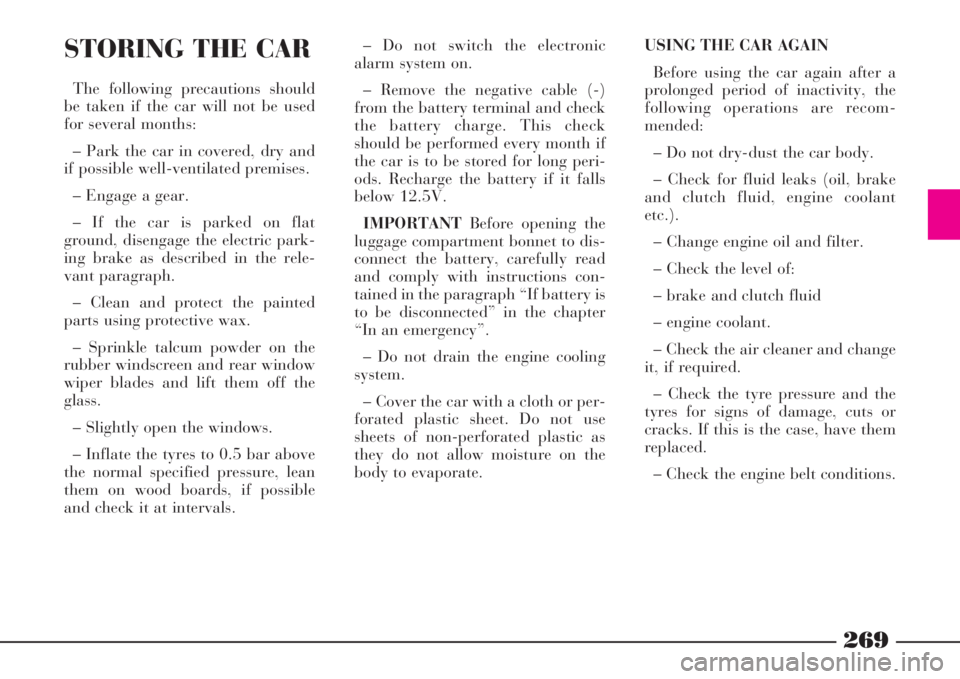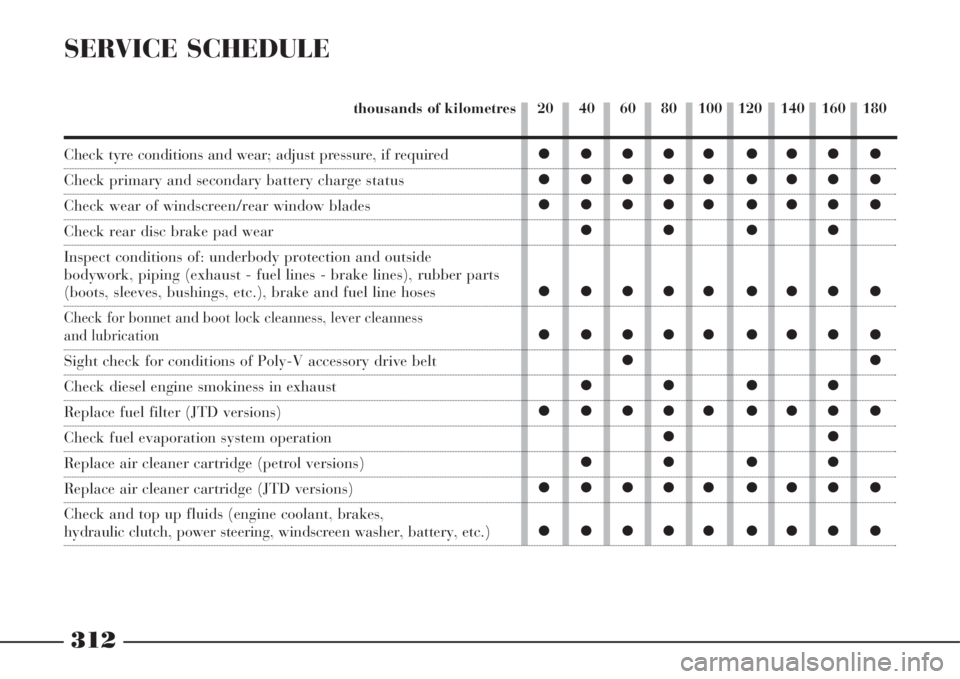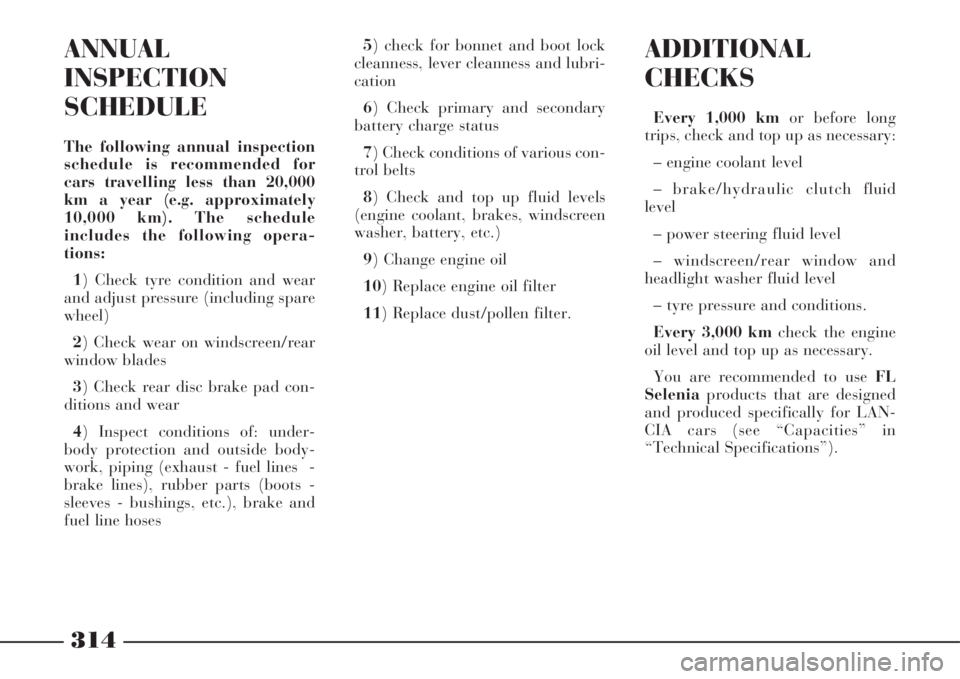engine coolant Lancia Thesis 2009 Owner handbook (in English)
[x] Cancel search | Manufacturer: LANCIA, Model Year: 2009, Model line: Thesis, Model: Lancia Thesis 2009Pages: 386, PDF Size: 4.96 MB
Page 170 of 386

169
OPERATION
WITH ENGINE RUNNING
“Supplementary heater” mode
This operating mode integrates the
engine coolant warming up, immedi-
ately after start up or during driving,
to reach and keep the optimal work-
ing temperature of the engine and the
passenger compartment heater in the
quickest way.
This mode is activated automatically
by the climate control unit when the
following conditions occur at the same
time:
– ignition key at MAR
– engine running– coolant temperature lower than 30
°C
– the climate control unit detects
(according to sensor detected temper-
atures) that fast passenger compart-
ment warming is required.
This mode is automatically deacti-
vated when one of the following con-
ditions occurs:
– coolant temperature higher than
70 °C
– the heater control unit detects a
fault in the supplementary heater
– engine off. The batteries must be replaced with
new ones of the same type, available
at the usual sellers.
To replace batteries:
– remove the remote control cover
by pushing it in the arrow direction
indicated on the cover
– remove exhausted batteries and
take note of their position
– fit the new batteries with pole (+)
towards the remote control antenna
– fit down the cover.
Request for additional remote
controls
The heater receiver will acknowl-
edge up to three remote controls. To
order new remote controls, or to re-
place the original one, contact a Lan-
cia Dealership.
Page 253 of 386

252
IMPORTANTEnergy-absorbing
devices (climate control system,
heated rear window etc.) are auto-
matically disconnected at starting.
If the engine does not start at the
first attempt, return the ignition key
toSTOPbefore trying to start the
engine again.
If starting is particularly diffi-
cult,(with the Lancia CODE system
working properly) do not keep try-
ing too many times.
Use an auxiliary battery only if the
battery has insufficient charge.
Never use a battery charger to start
the engine. ENGINE WARMING UP
– Begin to move forward slowly let-
ting the engine turn at medium revs.
Do not accelerate abruptly.
– Do not push the engine to its limit
for the first few kilometers. You are
recommended to wait until the
coolant temperature has reached 50
to 60 °C.STOPPING THE ENGINE
– Release the accelerator pedal and
wait until the engine is idling.
– Turn the ignition key to STOP
and turn the engine off. For versions
with electronic automatic gearbox,
put the selector to Pbefore turning
the engine off.
IMPORTANTAfter a taxing drive
you should allow the engine to
“catch its breath” before turning it
off by letting it idle to allow the tem-
perature in the engine compartment
to fall.
Page 256 of 386

255
SAFE DRIVING
In designing THESIS, LANCIA has
made every effort to come up with a
car able to provide driver and pas-
senger with top-class levels of safety.
Nevertheless it is always the behav-
iour of the person at the wheel that
determines road safety.
Below you will find some simple
tips to help you travel in safety
under different conditions. You will
no doubt be familiar with many of
them already, but it will be useful to
read them all carefully.
BEFORE GETTING BEHIND
THE WHEEL
– Make sure all lights, including
the headlights, are working proper-
ly.
– Adjust the position of the seats,
steering wheel, driving and door
mirrors properly for the best driving
position.
– Carefully adjust the head
restraints so that the back of the
head and not the nape of the neck is
supported.Make sure that nothing (mats etc.)
gets in the way of the pedals when
they are pushed down.
– Make sure that any child
restraint systems (child seats, carri-
ers etc.) are properly fixed on the
rear seat.
– Place any objects in the boot in
such a way that they cannot be
thrown forwards in the event of an
accident.
– Do not eat a heavy meal before
travelling. Light eating will help
keep your reflexes prompt. Above
all, do not have anything alcoholic to
drink.
Periodically, remember to check:
– tyre pressure and conditions;
– engine oil level;
– coolant level and cooling system
conditions;
– brake fluid level;
– power steering fluid level;
– windscreen washer fluid level. WHEN TRAVELLING
– The first rule of safe driving is
prudence.
– Prudence also means putting
yourself into a position where you
can predict wrong or imprudent
behaviour from other drivers.
– Stick closely to the rules of the
road in the particular country where
the vehicle is being driven and,
above all, do not exceed speed limits.
– Ensure that, besides yourself, all
the other passengers in the vehicle
have their seat belts fastened, that
children are sitting in the appropri-
ate child seats and any animals in
the car are placed in suitable com-
partments.
– You should be physically fit and
mentally alert before setting out on
long journeys.
Page 270 of 386

269
USING THE CAR AGAIN
Before using the car again after a
prolonged period of inactivity, the
following operations are recom-
mended:
– Do not dry-dust the car body.
– Check for fluid leaks (oil, brake
and clutch fluid, engine coolant
etc.).
– Change engine oil and filter.
– Check the level of:
– brake and clutch fluid
– engine coolant.
– Check the air cleaner and change
it, if required.
– Check the tyre pressure and the
tyres for signs of damage, cuts or
cracks. If this is the case, have them
replaced.
– Check the engine belt conditions.STORING THE CAR
The following precautions should
be taken if the car will not be used
for several months:
– Park the car in covered, dry and
if possible well-ventilated premises.
– Engage a gear.
– If the car is parked on flat
ground, disengage the electric park-
ing brake as described in the rele-
vant paragraph.
– Clean and protect the painted
parts using protective wax.
– Sprinkle talcum powder on the
rubber windscreen and rear window
wiper blades and lift them off the
glass.
– Slightly open the windows.
– Inflate the tyres to 0.5 bar above
the normal specified pressure, lean
them on wood boards, if possible
and check it at intervals.– Do not switch the electronic
alarm system on.
– Remove the negative cable (-)
from the battery terminal and check
the battery charge. This check
should be performed every month if
the car is to be stored for long peri-
ods. Recharge the battery if it falls
below 12.5V.
IMPORTANTBefore opening the
luggage compartment bonnet to dis-
connect the battery, carefully read
and comply with instructions con-
tained in the paragraph “If battery is
to be disconnected” in the chapter
“In an emergency”.
– Do not drain the engine cooling
system.
– Cover the car with a cloth or per-
forated plastic sheet. Do not use
sheets of non-perforated plastic as
they do not allow moisture on the
body to evaporate.
Page 313 of 386

312
SERVICE SCHEDULE
20 40 60 80 100 120 140 160 180 thousands of kilometres
ççççç çççç
ççççç çççç
ççççç çççç
çç çç
ççççç çççç
ççççç çççç
çç
çç çç
ççççç çççç
çç
çç çç
ççççç çççç
ççççç ççççCheck tyre conditions and wear; adjust pressure, if required
Check primary and secondary battery charge status
Check wear of windscreen/rear window blades
Check rear disc brake pad wear
Inspect conditions of: underbody protection and outside
bodywork, piping (exhaust - fuel lines - brake lines), rubber parts
(boots, sleeves, bushings, etc.), brake and fuel line hoses
Check for bonnet and boot lock cleanness, lever cleanness
and lubrication
Sight check for conditions of Poly-V accessory drive belt
Check diesel engine smokiness in exhaust
Replace fuel filter (JTD versions)
Check fuel evaporation system operation
Replace air cleaner cartridge (petrol versions)
Replace air cleaner cartridge (JTD versions)
Check and top up fluids (engine coolant, brakes,
hydraulic clutch, power steering, windscreen washer, battery, etc.)
Page 315 of 386

314
ADDITIONAL
CHECKS
Every 1,000 kmor before long
trips, check and top up as necessary:
– engine coolant level
– brake/hydraulic clutch fluid
level
– power steering fluid level
– windscreen/rear window and
headlight washer fluid level
– tyre pressure and conditions.
Every 3,000 kmcheck the engine
oil level and top up as necessary.
You are recommended to use FL
Seleniaproducts that are designed
and produced specifically for LAN-
CIA cars (see “Capacities” in
“Technical Specifications”).
ANNUAL
INSPECTION
SCHEDULE
The following annual inspection
schedule is recommended for
cars travelling less than 20,000
km a year (e.g. approximately
10,000 km). The schedule
includes the following opera-
tions:
1) Check tyre condition and wear
and adjust pressure (including spare
wheel)
2) Check wear on windscreen/rear
window blades
3) Check rear disc brake pad con-
ditions and wear
4) Inspect conditions of: under-
body protection and outside body-
work, piping (exhaust - fuel lines -
brake lines), rubber parts (boots -
sleeves - bushings, etc.), brake and
fuel line hoses5) check for bonnet and boot lock
cleanness, lever cleanness and lubri-
cation
6) Check primary and secondary
battery charge status
7) Check conditions of various con-
trol belts
8) Check and top up fluid levels
(engine coolant, brakes, windscreen
washer, battery, etc.)
9) Change engine oil
10) Replace engine oil filter
11) Replace dust/pollen filter.
Page 318 of 386

317
CHECKING
FLUID LEVELS
1) Engine oil
2) Brake fluid
3) Windscreen/rear window and
headlight washer fluid
4) Engine coolant
5) Power steering fluid
L0A0343b
L0A0344b
fig. 1 - 2.0 TB version
fig. 2 - 2.4 - 2.4 CAE versions
Page 319 of 386

318
1) Engine oil
2) Brake fluid
3) Windscreen/rear window and
headlight washer fluid
4) Engine coolant
5) Power steering fluid
L0A0345b
L0A0341b
fig. 3 - 2.4 JTD version
fig. 4 - 2.4 JTD
20V- 2.4 JTD 20VCAE versions
Page 320 of 386

319
1) Engine oil
2) Brake fluid
3) Windscreen/rear window and
headlight washer fluid
4) Engine coolant
5) Power steering fluid
L0A0342b
L0A0358b
fig. 5 - 3.0 V6 CAE version
fig. 6 - 3.2 V6 CAE version
Page 322 of 386

321
IMPORTANTThe oil consump-
tion depends on the driving style and
the conditions under which the car is
used.Used engine oil and re-
placed oil filters contain
substances which can harm
the environment. We recommend
you have the car seen to at a Lan-
cia Dealership for the oil and filter
change. It is suitably equipped for
disposing of used oil and filters in
an environmentally friendly way
that complies with the law.ENGINE COOLANT (fig. 13)
Do not remove the reser-
voir cap when the engine is
hot: you risk scalding
yourself!
Check coolant level when the engine
is cold and with the car on flat
ground. The level should be includ-
ed between MINandMAXreference
lines on the reservoir.
If the level is low, loosen the reser-
voir cap Aand top up with
PARAFLU UPuntil reaching the
MAXreference line.
fig. 9 - 2.4 JTD version
L0A0324b
fig. 11 - 3.0 V6 CAE version
L0A0155b
fig. 13
L0A0292b
fig. 10 - 2.4 JTD 20V-
2.4 JTD 20VCAE versionsfig. 12 - 3.2 V6 CAE version
L0A0346bL0A0359b